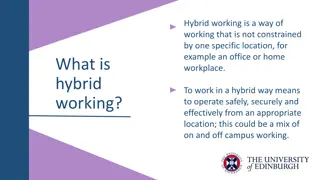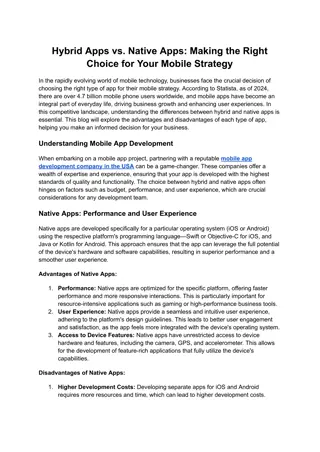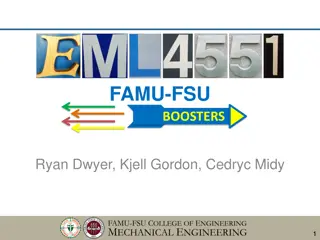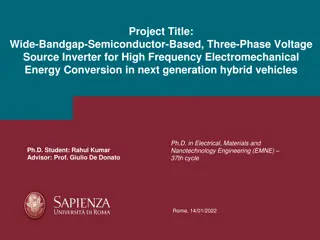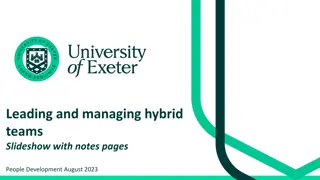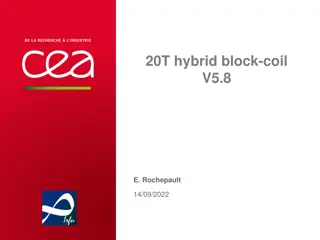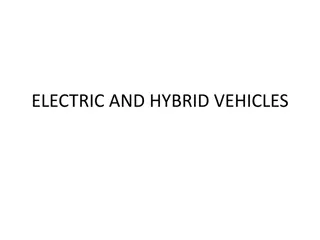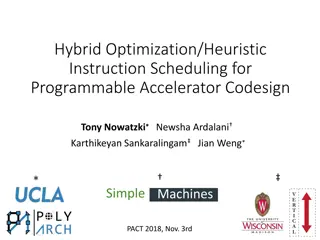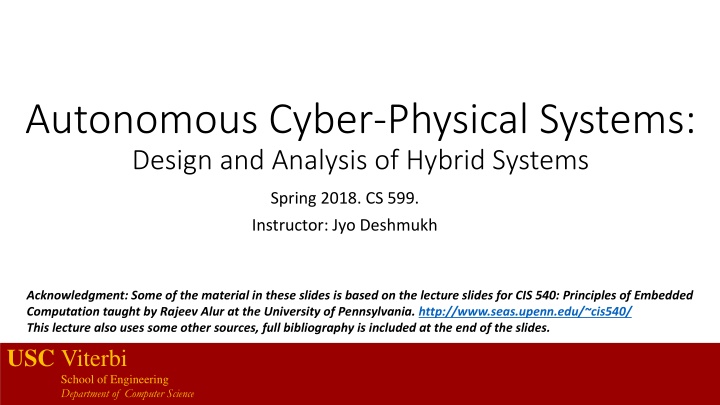
Design and Analysis of Hybrid Systems for Autonomous Cyber-Physical Systems
Explore the design and analysis of hybrid systems in the context of Autonomous Cyber-Physical Systems. Topics include formalization, stability analysis, reachability analysis, and applications such as obstacle avoidance for robots. Learn about inputs, outputs, states, and executions of hybrid processes with continuous and discrete components. Dive into the intricacies of hybrid system modeling and design for advanced autonomous systems in this comprehensive course.
Download Presentation

Please find below an Image/Link to download the presentation.
The content on the website is provided AS IS for your information and personal use only. It may not be sold, licensed, or shared on other websites without obtaining consent from the author. If you encounter any issues during the download, it is possible that the publisher has removed the file from their server.
You are allowed to download the files provided on this website for personal or commercial use, subject to the condition that they are used lawfully. All files are the property of their respective owners.
The content on the website is provided AS IS for your information and personal use only. It may not be sold, licensed, or shared on other websites without obtaining consent from the author.
E N D
Presentation Transcript
Autonomous Cyber-Physical Systems: Design and Analysis of Hybrid Systems Spring 2018. CS 599. Instructor: Jyo Deshmukh Acknowledgment: Some of the material in these slides is based on the lecture slides for CIS 540: Principles of Embedded Computation taught by Rajeev Alur at the University of Pennsylvania. http://www.seas.upenn.edu/~cis540/ This lecture also uses some other sources, full bibliography is included at the end of the slides. USC Viterbi School of Engineering Department of Computer Science
Layout Hybrid Systems Background Hybrid Process Formalization Stability analysis for hybrid systems Reachability analysis for hybrid systems Hybrid Systems applications Model-based Design V Obstacle-avoidance for robots USC Viterbi School of Engineering Department of Computer Science 2
Hybrid Process Inputs, Outputs, States (both continuous and discrete), Internal actions, input and output actions exactly like the asynchronous model Continuous action/transition: Discrete mode ? does not change ?(0) = ?? ?? ? ?? satisfies the given dynamical equation for mode ? Output ? satisfies the output equation for mode ?: ? ? = ?(? ? ,? ? ) At all times ? 0,? ,the state ? ? satisfies the invariant for mode ? ?(?)/?(?) (?,? ?) ?,? t + ? ? USC Viterbi School of Engineering Department of Computer Science 3
Hybrid Process ?(?)/? ? ? Discrete action/transition: Happens instantaneously Changes discrete mode ? to ? Can execute only if ?(??) evaluates to true Changes state variable value from ?? to ? ?? ? ?? should satisfy mode invariant of ? Some definitions make ? a function of ?and ? Output will change from ??? to ? ? ?? (?,? ?) ? ,? ?? USC Viterbi School of Engineering Department of Computer Science 4
Executions of a hybrid process (0,3) ?4 ?3 ?9 At each cell boundary, assume that the guard is the equation of the boundary, and the reset is ? ? + ?,? ? + ?, where ? = 0.01 Invariant for each cell/mode is the open set enclosed by its boundaries Suppose initial state is (0,0.9) ? = 1 ? = 0.5 ? = 1 ? = 1 ? = 0 ? = 0 (0,2) ?5 ?8 ?2 ? = 0 ? = 1 ? = 1 ? = 1 ? = 0.5 ? = 1 (0,1) ?1 ?7 ?6 ? = 0.5 ? = 1 ? = 1? ?,? += ? ? = 1 ? = 1 ? = 1 ? = 0.5 (?1,0,0.9) ??,0.11,1.01 ?1,0.1,1 (0,0) 0.1 2 ? = 2? ?,? += ? (2,0) (3,0) (1,0) 0.99 ??,0.11,2 ??,0.12,2.01 USC Viterbi School of Engineering Department of Computer Science 5
Stability of hybrid systems Hybrid systems can have surprising results with respect to stability No uniform method like Lyapunov analysis for analyzing all hybrid systems Example: Piecewise Linear (PWL) Dynamical System Special class of hybrid system, in which each mode has linear dynamics, guards, resets are all linear/affine Each mode in the PWL system can have stable dynamics (by doing eigen- value analysis), but resulting hybrid system may be unstable! USC Viterbi School of Engineering Department of Computer Science 6
Example ?2= 0.2?1 ? 1 10 100 1 1 100 10 1 ? = ? ? = ? ?2= 5?1 ? Dynamics in each mode are stable! USC Viterbi School of Engineering Department of Computer Science 7
Simulation results ?2 ?2= 5?1 ?2= 0.2?1 Initial State ?1 USC Viterbi School of Engineering Department of Computer Science 8
Stability analysis for hybrid systems Two main approaches1,2: Find a common Lyapunov function that works for all modes I.e. for each mode ?, dynamics are ? = ??? , find ? ? such that: ? ? ?:?? ????? < 0, and ? ? ? ? > 0 Usually hard to find a one-size-fits-all Lyapunov function Find multiple Lyapunov functions, one for each mode In each mode its Lyapunov function value decreases, and at the switching instant the destination mode s Lyapunov function value does not increase ??(?) value decreases every time mode ? is entered Finding Lyapunov functions satisfying these conditions is again hard USC Viterbi School of Engineering Department of Computer Science 9
Reachability analysis (0,3) ?4 ?3 ????? Suppose the grid world represents the configuration space of a robot ? = 1 ? = 0.5 ? = 1 ? = 1 ? = 0 ? = 0 How do we analyze: Does the robot reach the error cell? Easy if we have only one initial state: just simulate! (0,2) ?5 ?8 ?2 ? = 0 ? = 1 ? = 1 ? = 1 ? = 0.5 ? = 1 (0,1) ?1 ?7 ?6 ? = 0.5 ? = 1 ? = 1 ? = 1 ? = 1 ? = 0.5 What if the initial position of the robot is not certain (could be a set)? (0,0) (2,0) (3,0) (1,0) What if the dynamics are not certain? Initial states USC Viterbi School of Engineering Department of Computer Science 10
Time-bounded Reachability Analysis Fundamental problem for dynamical systems Simulation: Given an initial condition ? 0 = ?0, compute solution ?(?) such that d? ? = ?(x t ) ?? Time-bounded Reachability: Given a set of initial conditions ? 0 ?0, and a time T, compute the set ????? ,? such that ? 0,? :? ? ????? ,? A useless (but correct) answer is ????? ,?= ? How do we find a tight reachable set? USC Viterbi School of Engineering Department of Computer Science 11
Computing Reachable Sets3 Main idea: compute successor states For a given set of states ?, ? ? ? ? ? ? ,?? | ?,?? ? ,?? ?????? = For a given set ?, ?????? = (?,?? ) | ?,?? ? (?,?? ) For a given set ?, compute ?????(?) and ?????? Use a recurrence relation to do fixpoint computation USC Viterbi School of Engineering Department of Computer Science 12
Fixpoint computation of reachable states Computation: Initialize ?0 ?0 (initial set of states) Recur: ??+1 ?? ??????? ?????(??) Terminate if: ??+1 = ?? Time-bounded: when the sum of time elapsed on all continuous transitions is ? Problems: Termination not guaranteed for general case ??????? is not easy to compute in general Error in computing ??????? can blow-up leading to answers that are too conservative Good tools for Hybrid processes with Linear Dynamics: SpaceEx (and a few others) Good tools for Hybrid processes with Nonlinear Dynamics: C2E2, Flow*, dReach, CORA (and a few others) USC Viterbi School of Engineering Department of Computer Science 13
Design Application: Autonomous Guided Vehicle Objective: Steer vehicle to follow a given track Control inputs: linear vehicle speed ? , vehicle angular velocity (?), start/stop Constraints on control inputs: ? ?max,?max/2,0 ? { ?,0,?} Designer choice: ? = ?max only if ? = 0, otherwise ? =?max 2 USC Viterbi School of Engineering Department of Computer Science 14
On/Off control for Path following ? Go straight Turn right ? ?? ? = (?max/2)cos? ? = ?max2 sin? ? = ? ? ? ? = ?maxcos? ? = ?maxsin? ? = 0 ? ? ? ? ? ? ?? ???????? ? ?? Track ??????? ? ?? ? ?? When ? ?,+? , controller decides that vehicle goes straight, otherwise executes a turn command to bring error back in the interval ? = (?max/2)cos? ? = ?max2 sin? ? = ? ? ? ? = 0 ? = 0 ? = 0 ??????? ? ?0 ? ?0 ? ?0 ???????? ? ?? Turn left Stationary USC Viterbi School of Engineering Department of Computer Science 15
Design Application: Robot Coordination Autonomous mobile robots in a room, goal for each robot: Reach a target at a known location Avoid obstacles (positions not known in advance) Minimize distance travelled Design Problems: Cameras/vision systems can provide estimates of obstacle positions When should a robot update its estimate of the obstacle position? Robots can communicate with each other How often and what information can they communicate? High-level motion planning What path in the speed/direction-space should the robots traverse? USC Viterbi School of Engineering Department of Computer Science 16
Path planning with obstacle avoidance ? Assumptions: Two-dimensional world Robots are just points Each robot travels with a fixed speed ?2 ?,?2 Obstacle 2 ??2= ??2,??2 ?2= ?2,?2 ??,?? Goal Dynamics for Robot ??: ??= ? cos??; ??= ? sin?? Design objectives: Eventually reach ??,?? Always avoid Obstacle1 and Obstacle 2 Minimize distance travelled Obstacle 1 ?1 ??1= ??1,??1 ?,?1 ?1= ?1,?1 ? USC Viterbi School of Engineering Department of Computer Science 17
Divide path/motion planning into two parts Computer vision tasks Actual path planning task 1. 2. Assume computer vision algorithm identifies obstacles, and labels them with some easy-to-represent geometric shape (such as a bounding boxes) In this example, we will assume a sonar-based sensor, so we will use circles Assuming the vision algorithm is correct, do path planning based on the estimated shapes of obstacles Design challenge: Estimate of obstacle shape is not the smallest shape containing the obstacle Shape estimate varies based on distance from obstacle USC Viterbi School of Engineering Department of Computer Science 18
Estimation error Robot ?1 maintains radii ?1 and ?2 that are estimates of obstacle sizes ??1= ??1,??1 Estimated shape from distance ? Every ? seconds, ?1 executes following update to get estimates of shapes of each obstacle: ?1 min ?1,?1+ ? ?2 min ?2,?2+ ? ?1 Estimated shape from distance ? ? ? Smallest shape bounding obstacle ?1 ??1 ?1 ?1 ??2 ?2 Computation of ?2 is symmetric Estimated radius ? = ? + ?(? ?), where ? [0,1] is a constant USC Viterbi School of Engineering Department of Computer Science 19
Path planning Choose shortest path ?3 to target (to minimize time) ? If estimate of obstacle 1 intersects ?3, calculate two paths that are tangent to obstacle 1 estimate ?1 (??,??) ?4 ??1 If estimate of obstacle 2 intersects ?3, or obstacle 1, calculate tangent paths ?3 ?2 ??2 ?1 Plausible paths: ?1 and ?2 Calculate shorter one as the planned path ? USC Viterbi School of Engineering Department of Computer Science 20
Dynamic path planning Path planning inputs: Current position of robot Target position Position of obstacles and estimates Output: Direction for motion assuming obstacle estimates are correct May be useful to execute planning algorithm again as robot moves! Because estimates will improve closer to the obstacles Invoke planning algorithm every ? seconds USC Viterbi School of Engineering Department of Computer Science 21
Communication improves planning Every robot has its own estimate of the obstacle ?2 s estimate of obstacle might be better than ?1 s Strategy: every ? seconds, send estimates to other robot, and receive estimates ???? For estimate ??, use final estimate = min ??,?? Re-run path planner USC Viterbi School of Engineering Department of Computer Science 22
Improved path planning through communication ? ? New path available because estimate of obstacle 1 improved after receiving estimate from ?2 ?1 ?1 (??,??) (??,??) ?4 ?4 ??1 ??1 ?1(0) ?3 ?3 ?2 ?2 ??2 ??2 ?1(?) Old path ?1 ? ? USC Viterbi School of Engineering Department of Computer Science 23
Advantage of using hybrid processes See Fig. 9.19 in book for hybrid process for a robot Hybrid process combines computation, communication and control Elegant machine that exemplifies the basic operation of a cyber-physical system Allows design-space exploration through simulations and reachability analysis We can check effect of parameter choices on the behavior of the system USC Viterbi School of Engineering Department of Computer Science 24
Bibliography H. Lin and P. J. Antsaklis, "Stability and Stabilizability of Switched Linear Systems: A Survey of Recent Results," in IEEE Transactions on Automatic Control, vol. 54, no. 2, pp. 308-322, Feb. 2009. 1. Branicky, Michael S. "Multiple Lyapunov functions and other analysis tools for switched and hybrid systems." IEEE Transactions on automatic control 43.4 (1998): 475-482. 2. Talk by Goran Frehse, pdf of slides here: http://qmc.cs.aau.dk/slides/slides-frehse.pdf 3. SpaceEx: http://spaceex.imag.fr/ 4. Flow*: https://flowstar.org/ 5. dReach: http://dreal.github.io/dReach/ 6. CORA: http://www.i6.in.tum.de/Main/SoftwareCORA 7. USC Viterbi School of Engineering Department of Computer Science 25






